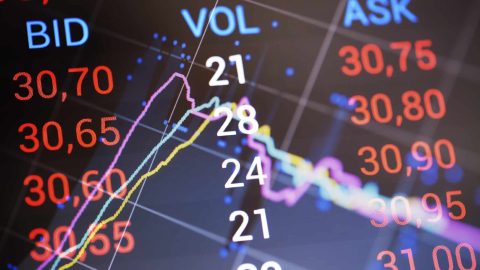The losses on the stock exchanges and in other risky asset classes unsettle investors. The additional expansive signals sent by the central bank support markets, albeit only by a minor degree. From an economic perspective there are no convincing signs for a trend reversal. The current correction is due to permanently low growth and to the risk of further deterioration.
The indicators suggesting sustainably low economic growth are increasing in numbers, both with respect to real economic growth and to inflation (and thus nominal growth). The expectations/estimates for global economic growth are only gradually adjusted to these lower levels. In fact, the trend of downward revisions for economic growth is an ongoing one.
The downside risks have increased
This is due to the adjustment process in the wake of the boom years in the emerging markets and to the increase in the risk of recession in the USA. The transformation of the growth drivers in China towards the service sector has caused commodity prices to slump, setting off global ripples. Commodity-producing countries and sectors are in recession. Also, credit growth is falling as we speak. This environment weighs heavy on economic growth, industrial production, exports, and prices of goods worldwide.
In the USA economic growth has decreased substantially. Also, the balance sheet ratios in the corporate sector, especially gearing, have deteriorated. At the same time banks have tightened their lending conditions for companies. Both industrial production and new orders taken in the long-term capital goods segment are already sliding. Most recently, the service sector has been sending weaker signals as well. At least private housebuilding and private consumer spending are still going strong.
This environment explains the widening of spreads demanded for default and equity risk. This means the stress in the financial system has increased. And it also applies to European banks. The risk of negative feedback from the banking sector and the real economy has increased. Therefore the rate of inflation priced into bond yields is continuously falling to new lows. The risk of deflation is elevated.
Further interest rate hikes in the USA are unlikely
The “big” central banks accommodate these developments in their strategies. The Japanese central bank has joined the ranks of those central banks pursuing a negative interest rate policy. The European Central Bank issued clear signals of further loosening in March. The US Fed is monitoring these developments very closely and currently shows no intention of raising the Fed funds rate further. A rate hike by the Fed this year is unlikely. The stagnating monetary base in the USA is already restrictive enough for the global economy.
Seen from a positive angle, markets tend to price in recessions more often than they actually occur. Any slightly sustainable stabilisation of the Chinese currency, the oil price, inflation expectations, and lending conditions as well as further supporting measures especially in China could trigger a temporary recovery of equity and credit markets.
From a negative perspective, the conclusion would be: economists very rarely predict a recession. This means that it would catch many economists off-guard.
Legal disclaimer
This document is an advertisement. Unless indicated otherwise, source: Erste Asset Management GmbH. The language of communication of the sales offices is German and the languages of communication of the Management Company also include English.
The prospectus for UCITS funds (including any amendments) is prepared and published in accordance with the provisions of the InvFG 2011 as amended. Information for Investors pursuant to § 21 AIFMG is prepared for the alternative investment funds (AIF) administered by Erste Asset Management GmbH pursuant to the provisions of the AIFMG in conjunction with the InvFG 2011.
The currently valid versions of the prospectus, the Information for Investors pursuant to § 21 AIFMG, and the key information document can be found on the website www.erste-am.com under “Mandatory publications” and can be obtained free of charge by interested investors at the offices of the Management Company and at the offices of the depositary bank. The exact date of the most recent publication of the prospectus, the languages in which the fund prospectus or the Information for Investors pursuant to Art 21 AIFMG and the key information document are available, and any other locations where the documents can be obtained are indicated on the website www.erste-am.com. A summary of the investor rights is available in German and English on the website www.erste-am.com/investor-rights and can also be obtained from the Management Company.
The Management Company can decide to suspend the provisions it has taken for the sale of unit certificates in other countries in accordance with the regulatory requirements.
Note: You are about to purchase a product that may be difficult to understand. We recommend that you read the indicated fund documents before making an investment decision. In addition to the locations listed above, you can obtain these documents free of charge at the offices of the referring Sparkassen bank and the offices of Erste Bank der oesterreichischen Sparkassen AG. You can also access these documents electronically at www.erste-am.com.
Our analyses and conclusions are general in nature and do not take into account the individual characteristics of our investors in terms of earnings, taxation, experience and knowledge, investment objective, financial position, capacity for loss, and risk tolerance. Past performance is not a reliable indicator of the future performance of a fund.
Please note: Investments in securities entail risks in addition to the opportunities presented here. The value of units and their earnings can rise and fall. Changes in exchange rates can also have a positive or negative effect on the value of an investment. For this reason, you may receive less than your originally invested amount when you redeem your units. Persons who are interested in purchasing units in investment funds are advised to read the current fund prospectus(es) and the Information for Investors pursuant to § 21 AIFMG, especially the risk notices they contain, before making an investment decision. If the fund currency is different than the investor’s home currency, changes in the relevant exchange rate can positively or negatively influence the value of the investment and the amount of the costs associated with the fund in the home currency.
We are not permitted to directly or indirectly offer, sell, transfer, or deliver this financial product to natural or legal persons whose place of residence or domicile is located in a country where this is legally prohibited. In this case, we may not provide any product information, either.
Please consult the corresponding information in the fund prospectus and the Information for Investors pursuant to § 21 AIFMG for restrictions on the sale of the fund to American or Russian citizens.
It is expressly noted that this communication does not provide any investment recommendations, but only expresses our current market assessment. Thus, this communication is not a substitute for investment advice.
This document does not represent a sales activity of the Management Company and therefore may not be construed as an offer for the purchase or sale of financial or investment instruments.
Erste Asset Management GmbH is affiliated with the Erste Bank and austrian Sparkassen banks.
Please also read the “Information about us and our securities services” published by your bank.


